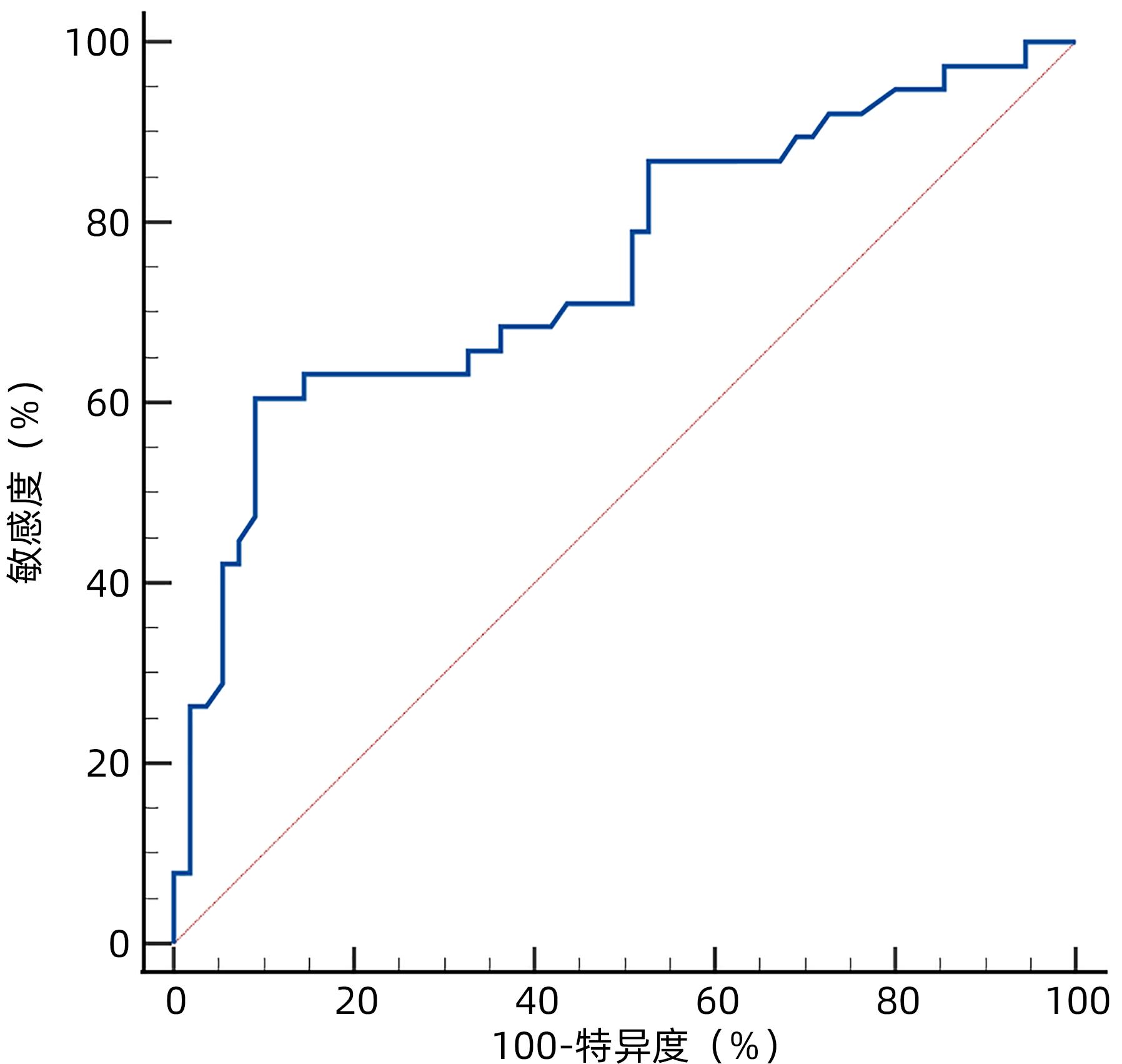肝硬化自发性门体分流与肝肾综合征的相关性研究
DOI: 10.3969/j.issn.1001-5256.2023.12.012
Association between spontaneous portosystemic shunt and hepatorenal syndrome in liver cirrhosis
-
摘要:
目的 探讨肝硬化合并自发性门体分流(SPSS)与肝肾综合征(HRS)的相关性。 方法 回顾性选取山东大学齐鲁医院德州医院2015年1月—2022年1月SPSS患者93例,并以HRS的发生作为观察终点随访12个月。以有无HRS分组,93例SPSS患者分为HRS组(38例,40.86%)与非HRS组(55例,59.14%),分析两组间临床资料、实验室数据、并发症情况、分流直径大小的差异。以分流静脉最大直径1.5 cm分组,93例SPSS患者分为高分流组(52例,55.91%)与低分流组(41例,44.09%),以HRS的发生为观察终点,比较两组HRS的发生率及生存时间曲线。符合正态分布且方差齐的计量资料两组间比较采用成组t检验,计数资料两组间比较采用χ2检验。截断值预测采用受试者工作特征曲线(ROC曲线),生存时间对比采用Kaplan-Meier曲线分析,生存曲线的差异分析采用Log-rank检验法。危险因素分析采用单因素及多因素Cox回归。 结果 与非HRS组对比,HRS组Child-Pugh评分及分级、MELD评分、血肌酐(SCr)、尿素氮(BUN)、ALT、AST、分流静脉最大直径、肝性脑病、自发性腹膜炎发生率、腹水程度增高,门静脉主干直径、血清钠(Na)、血清Alb降低,差异均有统计学意义(P值均<0.05)。与低分流组对比,高分流组的HRS发生率增高(51.92% vs 26.83%,χ2=5.974,P=0.015)、发生时间缩短(Log-rank,P=0.033)。SPSS患者发生HRS的独立危险因素包括分流静脉最大直径>1.5 cm(HR=1.123,95%CI:1.041~1.211,P=0.003)、MELD评分增加(HR=1.205,95%CI:1.076~1.437,P=0.039)、血清Alb降低(HR=0.890,95%CI:0.814~0.974,P=0.011)、腹水程度增加(HR=2.099,95%CI:1.066~4.130,P=0.032)、自发性腹膜炎(HR=2.259,95%CI:1.020~5.003,P=0.045)。 结论 SPSS与HRS存在相关性,分流直径>1.5 cm是SPSS患者发生HRS的独立危险因素,需临床重视并早期干预。 Abstract:Objective To investigate the association between spontaneous portosystemic shunt (SPSS) and hepatorenal syndrome (HRS) in patients with liver cirrhosis. Methods A retrospective analysis was performed for 93 patients with SPSS from Dezhou Hospital, Qilu Hospital of Shandong University, from January 2015 to January 2022, and the patients were followed up for 12 months with the onset of HRS as the observation endpoint. According to the presence or absence of HRS, the 93 patients with SPSS were divided into HRS group with 38 patients (40.86%) and non-HRS group with 55 patients (59.14%), and the two groups were compared in terms of clinical data, laboratory data, complication, and shunt diameter. Based on the maximum shunt vein diameter of 1.5 cm, the 93 patients with SPSS were divided into high shunt group with 52 patients (55.91%) and low shunt group with 41 patients (44.09%), and with the onset of HRS as the observation endpoint, the two groups were compared in terms of the incidence rate of HRS and survival time curve. The independent-samples t test was used for comparison of normally distributed continuous data with homogeneity of variance between two groups, and the chi-square test was used for comparison of categorical data between two groups. The receiver operating characteristic (ROC) curve was used to predict cut-off values, the Kaplan-Meier curve was used for comparison of survival time, and the Log-rank test was used to compare the differences in survival curves. The multivariate Cox regression analysis was used to investigate risk factors. Results Compared with the non-HRS group, the HRS group had significant increases in Child-Pugh score, Child-Pugh class, MELD score, serum creatinine, blood urea nitrogen, alanine aminotransferase, aspartate aminotransferase, maximum shunt vein diameter, the incidence rates of hepatic encephalopathy and spontaneous bacterial peritonitis, and the degree of ascites, as well as significant reductions in main portal vein diameter, serum sodium and albumin (all P<0.05). Compared with the low shunt group, the high shunt group had a significant increase in the incidence rate of HRS (51.92% vs 26.83%, χ²=5.974, P=0.015) and a significant reduction in the time to the onset of HRS (Log-rank P=0.033). A maximum shunt vein diameter of >1.5 cm (hazard ratio [HR]=1.123, 95% confidence interval [CI]: 1.041 — 1.211, P=0.003), an increase in MELD score (HR=1.205, 95%CI: 1.076 — 1.437, P=0.039), a reduction in serum albumin (HR=0.890, 95%CI: 0.814 — 0.974, P=0.011), an increase in the degree of ascites (HR=2.099, 95%CI: 1.066 — 4.130, P=0.032), and spontaneous bacterial peritonitis (HR=2.259, 95%CI: 1.020 — 5.003, P=0.045) were independent risk factors for the onset of HRS in SPSS patients. Conclusion There is an association between SPSS and HRS, and shunt diameter >1.5 cm was an independent risk factor for HRS in SPSS patients, which should be taken seriously and require early intervention in clinical practice. -
表 1 SPSS患者基本资料比较
Table 1. Comparison of basic information of patients in SPSS
指标 HRS组(n=38) 非HRS组(n=55) 统计值 P 值 男/女(例) 20/18 26/29 χ2=0.258 0.676 年龄(岁) 57.39±11.81 59.91±12.48 t=0.976 0.332 病因(乙型肝炎/丙型肝炎/酒精性,例) 24/7/7 41/10/4 χ2=2.779 0.249 Child-Pugh评分 9.29±2.12 8.20±2.18 t=2.397 0.019 Child-Pugh分级(A/B/C,例) 4/18/16 14/31/10 χ2=7.533 0.023 MELD评分 29.51±9.92 22.78±16.41 t=2.259 0.026 Na(mmol/L) 102.33±20.32 125.43±18.73 t=5.648 <0.001 K(mmol/L) 4.02±0.86 4.12±0.97 t=0.539 0.592 Alb(g/L) 19.36±5.85 29.22±8.40 t=6.262 <0.001 RBC(×1012/L) 3.62±0.54 3.45±0.51 t=1.598 0.113 WBC(×109/L) 10.05±2.59 8.98±2.25 t=2.113 0.037 LY(×109/L) 1.01±0.15 1.07±0.17 t=1.729 0.087 SCr(μmol/L) 157.79±27.87 123.68±35.71 t=4.939 <0.001 BUN(μmol/L) 14.41±3.79 11.69±4.85 t=2.997 0.004 ALT(U/L) 46.31±16.40 30.21±16.88 t=4.572 <0.001 AST(U/L) 58.79±18.71 47.16±23.22 t=2.563 0.012 肝性脑病[例(%)] 26(68.42) 12(21.82) χ2=20.198 <0.001 上消化道出血[例(%)] 14(36.84) 21(38.18) χ2=0.017 0.896 自发性腹膜炎[例(%)] 23(60.53) 13(23.64) χ2=12.890 <0.001 门静脉血栓[例(%)] 12(31.58) 19(34.55) χ2=0.089 0.765 腹水程度(无/少/中/大量,例) 3/10/11/14 21/23/9/2 χ2=25.568 <0.001 门静脉主干直径(mm) 11.53±4.70 13.17±2.92 t=5.968 0.041 分流静脉最大直径(mm) 20.19±8.63 13.11±5.97 t=4.686 <0.001 注:K,血清钾;RBC,红细胞计数;LY,淋巴细胞计数。 表 2 SPSS患者发生HRS的单因素Cox回归分析
Table 2. Univariate Cox regression analysis of HRS occurrence in SPSS patients
因素 Wald值 HR 95%CI P值 Child-Pugh评分 0.270 1.054 0.864~1.287 0.603 Child-Pugh分级(A/B/C) 0.177 1.143 0.614~2.127 0.674 MELD评分 5.942 1.058 1.011~1.107 0.015 Na(mmol/L) 4.013 0.942 0.889~0.999 0.045 Alb(g/L) 4.873 0.936 0.882~0.993 0.027 WBC(×109/L) 5.788 1.297 1.107~1.520 0.016 SCr(μmol/L) 4.666 1.016 1.001~1.030 0.031 BUN(μmol/L) 0.643 0.422 0.957~1.110 0.422 ALT(U/L) 3.813 1.019 1.001~1.039 0.049 AST(U/L) 2.561 1.014 0.997~1.031 0.110 肝性脑病(有/无) 5.279 1.220 1.047~3.784 0.022 门静脉主干直径(mm) 0.095 0.758 0.912~1.069 0.758 分流直径(>1.5 cm/≤1.5 cm) 4.186 2.309 1.036~5.145 0.041 自发性腹膜炎(有/无) 6.463 1.786 1.378~3.211 0.011 腹水程度(无/少/中/大量) 8.648 1.726 1.200~2.483 0.003 表 3 SPSS患者发生HRS的多因素Cox回归分析
Table 3. Multivariate Cox regression analysis of HRS occurrence in SPSS patients
因素 B值 SE Wald值 HR 95%CI P值 MELD评分 0.129 0.320 4.267 1.205 1.076~1.437 0.039 Na(mmol/L) -0.008 0.014 0.355 0.992 0.965~1.019 0.551 Alb(g/L) -0.116 0.046 6.445 0.890 0.814~0.974 0.011 SCr(μmol/L) -0.004 0.012 0.115 0.996 0.972~1.020 0.735 ALT(U/L) -0.001 0.012 0.013 0.999 0.975~1.023 0.909 分流直径(>1.5 cm/≤1.5 cm) 0.116 0.039 9.012 1.123 1.041~1.211 0.003 肝性脑病(有/无) -0.326 0.607 0.288 0.722 0.220~2.373 0.592 自发性腹膜炎(有/无) 0.815 0.406 4.034 2.259 1.020~5.003 0.045 腹水程度(无/少/中/大量) 0.741 0.345 4.604 2.099 1.066~4.130 0.032 -
[1] RATHI S, BROCCO S, FORMENTIN C, et al. Spontaneous portosystemic shunts in cirrhosis: Detection, implications, and clinical associations[J]. Dig Liver Dis, 2021, 53( 11): 1468- 1475. DOI: 10.1016/j.dld.2020.11.020. [2] AMIN AA, ALABSAWY EI, JALAN R, et al. Epidemiology, pathophysiology, and management of hepatorenal syndrome[J]. Semin Nephrol, 2019, 39( 1): 17- 30. DOI: 10.1016/j.semnephrol.2018.10.002. [3] Chinese Society of Hepatology, Chinese Medical Association. Chinese guidelines on the management of liver cirrhosis[J]. J Clin Hepatol, 2019, 35( 11): 2408- 2425. DOI: 10.3969/j.issn.1001-5256.2019.11.006.中华医学会肝病学分会. 肝硬化诊治指南[J]. 临床肝胆病杂志, 2019, 35( 11): 2408- 2425. DOI: 10.3969/j.issn.1001-5256.2019.11.006. [4] Chinese Society of Hepatology, Chinese Medical Association. Guidelines on the management of ascites and complications in cirrhosis[J]. J Clin Hepatol, 2017, 33( 10): 1847- 1863. DOI: 10.3969/j.issn.1001-5256.2017.10.003.中华医学会肝病学分会. 肝硬化腹水及相关并发症的诊疗指南[J]. 临床肝胆病杂志, 2017, 33( 10): 1847- 1863. DOI: 10.3969/j.issn.1001-5256.2017.10.003. [5] WANG Y, XU Y, SUN W, et al. Value of interleukin-6 combined with Model for End-Stage Liver Disease score in predicting the prognosis of hepatitis B virus-related acute-on-chronic liver failure[J]. J Clin Hepatol, 2022, 38( 8): 1774- 1779. DOI: 10.3969/j.issn.1001-5256.2022.08.011.王艳, 徐英, 孙蔚, 等. IL-6联合终末期肝病模型评分对HBV相关慢加急性肝衰竭预后的预测价值[J]. 临床肝胆病杂志, 2022, 38( 8): 1774- 1779. DOI: 10.3969/j.issn.1001-5256.2022.08.011. [6] NARDELLI S, RIGGIO O, TURCO L, et al. Relevance of spontaneous portosystemic shunts detected with CT in patients with cirrhosis[J]. Radiology, 2021, 299( 1): 133- 140. DOI: 10.1148/radiol.2021203051. [7] LI WG, XU XY. Management of renal injury include hepatorenal syndrome in patients with decompensated liver cirrhosis[J]. Chin J Hepatol, 2020, 28( 5): 381- 385. DOI: 10.3760/cma.j.cn501113-20200427-00216.李文刚, 徐小元. 失代偿性肝硬化患者合并肾损伤与肝肾综合征的管理[J]. 中华肝脏病杂志, 2020, 28( 5): 381- 385. DOI: 10.3760/cma.j.cn501113-20200427-00216. [8] LIANG JQ, LIU W. Integrated traditional Chinese and Western medicine diagnosis and treatment of hepatorenal syndrome[J]. J Clin Hepatol, 2022, 38( 9): 1974- 1979. DOI: 10.3969/j.issn.1001-5256.2022.09.005.梁家琦, 刘汶. 肝肾综合征的中西医结合诊治[J]. 临床肝胆病杂志, 2022, 38( 9): 1974- 1979. DOI: 10.3969/j.issn.1001-5256.2022.09.005. [9] YANG LH, YANG JH. Mechanism and treatment of portal-systemic circulatory imbalance in hepatorenal syndrome[J]. J Clin Hepatol, 2021, 37( 12): 2770- 2773. DOI: 10.3969/j.issn.1001-5256.2021.12.006.杨黎宏, 杨晋辉. 肝肾综合征门体循环失衡的机制与治疗[J]. 临床肝胆病杂志, 2021, 37( 12): 2770- 2773. DOI: 10.3969/j.issn.1001-5256.2021.12.006. [10] Hepatobiliary Study Group of Chinese Society of Gastroenterology of Chinese Medical Association, Hepatology Committee of Chinese Research Hospital Association. Practice guidance for the use of terlipressin for liver cirrhosis related complications(2021)[J]. J Clin Hepatol, 2022, 38( 8): 1733- 1738. DOI: 10.3969/j.issn.1001-5256.2022.08.006.中华医学会消化病学分会肝胆疾病学组, 中国研究型医院学会肝病专业委员会. 特利加压素在肝硬化并发症临床应用的实践指导(2021版)[J]. 临床肝胆病杂志, 2022, 38( 8): 1733- 1738. DOI: 10.3969/j.issn.1001-5256.2022.08.006. [11] WANG JB. New concept of hepatorenal syndrome[J]. Chin J Dig, 2021, 41( 5): 312- 315. DOI: 10.3760/cma.j.cn311367-20210302-00131.王江滨. 肝肾综合征的新概念[J]. 中华消化杂志, 2021, 41( 5): 312- 315. DOI: 10.3760/cma.j.cn311367-20210302-00131. [12] KAZORY A, RONCO C. Hepatorenal syndrome or hepatocardiorenal syndrome: Revisiting basic concepts in view of emerging data[J]. Cardiorenal Med, 2019, 9( 1): 1- 7. DOI: 10.1159/000492791. [13] ZHANG XF, HE QJ, WANG HY, et al. An excerpt of report of the Baveno VII Consensus Workshop: Personalized care in portal hypertension[J]. J Clin Hepatol, 2022, 38( 6): 1258- 1268. DOI: 10.3969/j.issn.1001-5256.2022.06.010.张晓丰, 何钦俊, 王海玉, 等.《BavenoⅦ门静脉高压共识更新: 门静脉高压的个体化管理》摘译[J]. 临床肝胆病杂志, 2022, 38( 6): 1258- 1268. DOI: 10.3969/j.issn.1001-5256.2022.06.010. [14] HU JX, HAN T. An excerpt of diagnosis, evaluation, and management of ascites and hepatorenal syndrome: 2021 Practice Guidance by the American Association for the Study of Liver Diseases[J]. J Clin Hepatol, 2021, 37( 11): 2548- 2549. DOI: 10.3969/j.issn.1001-5256.2021.11.012.胡家轩, 韩涛.《2021年美国肝病学会实践指导: 腹水和肝肾综合征的诊断、评估和管理》摘译[J]. 临床肝胆病杂志, 2021, 37( 11): 2548- 2549. DOI: 10.3969/j.issn.1001-5256.2021.11.012. [15] LIAO XH, YE JZ, ZHONG BH. Pathogenesis of hepatorenal syndrome[J]. J Clin Hepatol, 2020, 36( 11): 2406- 2410. DOI: 10.3969/j.issn.1001-5256.2020.11.002.廖献花, 叶俊钊, 钟碧慧. 肝肾综合征的发病机制[J]. 临床肝胆病杂志, 2020, 36( 11): 2406- 2410. DOI: 10.3969/j.issn.1001-5256.2020.11.002. [16] ZHU BB, YANG JX, ZHANG Q, et al. Risk factors for the 90-day prognosis of patients with type I hepatorenal syndrome and establishment of a predictive model[J]. J Clin Hepatol, 2022, 38( 7): 1561- 1565. DOI: 10.3969/j.issn.1001-5256.2022.07.019.朱冰冰, 杨晋翔, 张群, 等. 1型肝肾综合征患者90天预后危险因素分析及预测模型构建[J]. 临床肝胆病杂志, 2022, 38( 7): 1561- 1565. DOI: 10.3969/j.issn.1001-5256.2022.07.019. [17] HAO SS, YAO J, YUAN LL. Analysis of prognostic factors for hepatorenal syndrome in patients with liver cirrhosis[J]. Chin Hepatol, 2021, 26( 2): 151- 154. DOI: 10.14000/j.cnki.issn.1008-1704.2021.02.015.郝莎莎, 姚佳, 原丽莉. 肝硬化并发肝肾综合征患者预后影响因素分析[J]. 肝脏, 2021, 26( 2): 151- 154. DOI: 10.14000/j.cnki.issn.1008-1704.2021.02.015. [18] Chinese Society of Hepatology, Chinese Society of Gastroenterology, and Chinese Society of Digestive Endoscopology of Chinese Medical Association. Guidelines on the management of esophagogastric variceal bleeding in cirrhotic portal hypertension[J]. J Clin Hepatol, 2023, 39( 3): 527- 538.中华医学会肝病学分会, 中华医学会消化病学分会, 中华医学会消化内镜学分会. 肝硬化门静脉高压食管胃静脉曲张出血的防治指南[J]. 临床肝胆病杂志, 2023, 39( 3): 527- 538. [19] SHANG YY, XU WT, GUO XZ, et al. Research progress on application of terlipressin in complications of liver cirrhosis[J]. Clin J Med Offic, 2022, 50( 9): 884- 886. DOI: 10.16680/j.1671-3826.2022.09.02.商一扬, 许文涛, 郭晓钟, 等. 特利加压素在肝硬化并发症中应用研究进展[J]. 临床军医杂志, 2022, 50( 9): 884- 886. DOI: 10.16680/j.1671-3826.2022.09.02. [20] ANGELI P, GARCIA-TSAO G, NADIM MK, et al. News in pathophysiology, definition and classification of hepatorenal syndrome: A step beyond the International Club of Ascites(ICA) consensus document[J]. J Hepatol, 2019, 71( 4): 811- 822. DOI: 10.1016/j.jhep.2019.07.002. -



 PDF下载 ( 776 KB)
PDF下载 ( 776 KB)


 下载:
下载:



